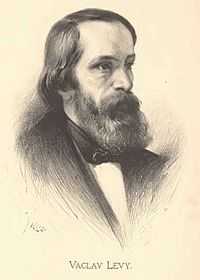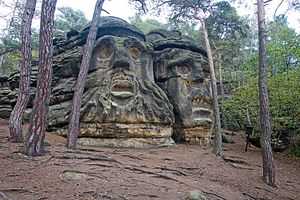Václav Levý

Václav Levý (14 September 1820, Nebřeziny, near Plasy[1] – 30 April 1870, Prague) was a Czech sculptor; considered to be one of the pioneers of the modern style in his country.
Biography
He was the son of a shoemaker. When he was two years old, the family moved to Kožlany, wher they remained. He showed an early aptitude for carving, creating several figures of the Virgin Mary and crucifixes. His parents were not sympathetic, however, and sought to apprentice him to a carpenter. At the urging of a local parson, he was sent away for an education, first to the Abbey in Pilsen, then to the Augustinian Monastery in Schlüsselburg, where he became a cook, later serving a brief apprenticeship in Dresden.[2]
Upon returning from Dresden, he made the chance acquaintance of Antonín Veith, a landowner who was also a patron of the arts, and entered his service as a cook at his estate in Liboch near Melnik in 1844.[2] His talent for sculpture was soon noticed by many of Veith's guests and, on the advice of the painter Josef Matěj Navrátil, he was sent to prague to study with the sculptor František Xaver Linn (1802–1848). However, Lévy came to the conclusion that Linn was a mediocre sculptor who had nothing to teach him, so he returned to Liboch.[2]

It was there, in 1845, at the suggestion of Veith's librarian, an Augustinian Professor from Brno named František Klácel, that Levý began creating the reliefs on a wooded hill near Liboch that are now known as Klácelka. Levý probably took his inspiration for the sculptures from Klácel's poem "Ferina Lišák" (a fable about a fox). The attention attracted by these reliefs encouraged Veith to send him to Munich for studies with Ludwig Schwanthaler, where he was taught the Academic style. It was here that he produced one of his best-known works "Adam and Eve" in 1849. He then returned to Klácelka, adding motifs from Czech history, as well as working on new decorations for the castle chapel.[3]
Career in Rome, Vienna, and back to Prague
Veith fell into financial difficulties and died suddenly in 1853, but Levý was able to survive as a free-lance sculptor and soon received a commission from the Sisters of Mercy Hospital near Petřín. Ultimately, however, he decided that he could not compete in the local sculpture market (which was dominated by the brothers Josef and Emanuel Max), so he applied for and received a stipendium to study in Rome.[2] This proved to be his most fruitful period and his contacts there led to several large commissions in Vienna.

Because of health problems (believed to be liver disease), he returned to Bohemia in 1867. He was given contracts for decorating the tympanum at the Church of Saints Cyril and Methodius and sculptural adornments for St. Vitus Cathedral,[2] but his worsening health gradually decreased his ability to work and he came to rely on his best student, Josef Václav Myslbek, whom he had met in Vienna.[4] He died of his illness in 1870 and was buried in Vyšehrad cemetery.
Other selected works
- 1846 - "Čertovy hlavy" (Devil's Heads), near Klácelka
- 1858 – "Madona na půlměsíci" (Madonna on the Crescent Moon) and "Kristus s Pannou Marií a Martou" (Christ with Mary and Martha), National Gallery of Prague
- 1861 – Saint Elizabeth of Thuringia (in Carrara marble), now in the Kunsthistorisches Museum, Vienna
- 1864 – Saint Jacob and seven reliefs in the church at Polička
- 1866 – Saint Agnes of Bohemia, in the Votive Church, Vienna
References
- ↑ Registration record of birth and baptism
- ↑ 2.0 2.1 2.2 2.3 2.4 Prostor-Architektura, interiér, design: Brief biography
- ↑ Jiři ŠimekIMEK, Zdeněk Rydygr, Bernard Kirschner. Zákupy a okolí na starých pohlednicích (Zákupy and Surroundings on Old Postcards). Petr Prášil, 2010. ISBN 978-80-86914-01-5
- ↑ Václav Štech. Josef V. Myslbek. Praha, Jan Štenc, 1922.
Further reading
- Český Rozhlas: Detailed biography by Josef Veselý, with illustrations. (online)
- Emanuel Poche (František Muzika, Josef Träger, editors): Václav Levý. Vol.55, Mánes Union of Fine Arts, Prague 1943.
- Josef Říman et al.: Malá československá encyklopedie Part 3 (I–L). Academia, Prague 1986, pg.878.
- Nová encyklopedie českého výtvarného umění (New Encyclopedia of Czech Fine Arts), ed. by Anděla Horová, First part (A-N). Prague, Academia 1999, pg.446
External links
| Wikimedia Commons has media related to Václav Levý. |
- Klácelka @ Má Vlast
- Václav Levý @ Wikizdroje
- List of Works relating to Levý in the National Library of the Czech Republic
|